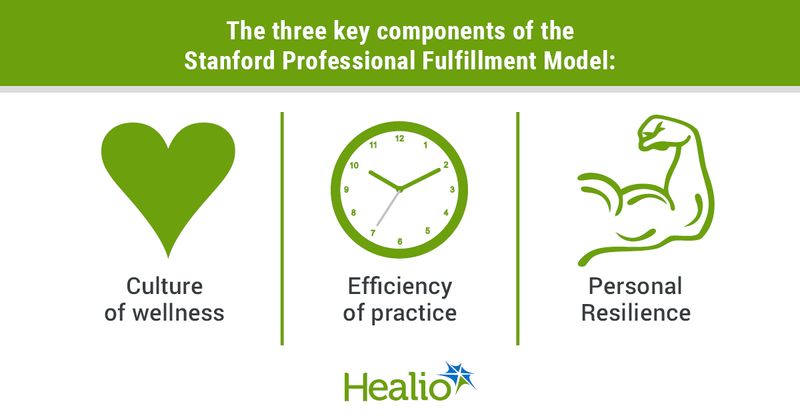Stanford Professional Fulfillment Model can help physicians find ‘joy again in work’
Key takeaways:
- A culture of wellness, efficiency of practice and personal resilience contribute to professional fulfillment, a speaker said.
- Employers should find a wellness model that fits their workers’ needs.
Professional fulfillment can be achieved through a culture of wellness, efficiency of practice in the workplace and personal resilience, according to a speaker at the Ending Clinician Burnout Global Summit.
Physician burnout is a pressing issue among all medical specialties. The Stanford WellMD & WellPhD Center developed a model to mitigate burnout by fostering a culture where health care professionals can “thrive in their work,” Heather Fitzgerald, DBe, MS, RN, director of the Office of Professional Fulfillment and Resilience at Stanford Medicine Children's Health, said in her presentation.

“We will have joy again in work in health care,” Fitzgerald said.
During her talk, Fitzgerald discussed her experience implementing the Stanford Professional Fulfillment Model at her institution.
Promoting a culture of wellness
There are three core elements of the model, according to Fitzgerald. The first is creating a culture of wellness by encouraging health care professionals to have compassion for themselves and their colleagues and promoting self-care and growth, according to information from Stanford’s website. To create this culture, Stanford formed peer support groups and enacted practices around moral distress mitigation and compassion cultivation.
Team resilience is another important part of the wellness culture, which Fitzgerald said is not the aggregate of each individual’s self-resilience but its own entity.
“I will have, understandably, variability in my access to my inherent capacity for resilience. On a given day, if I work on a resilient team, that team’s capacity for resilience is going to be buoyant and protective and will elevate me,” she said.
To assess workplace culture, Stanford distributes wellness surveys to its employees. Organization-wide results are presented to the dean, and division- and department-specific reports are shared with the respective heads who can schedule meetings to discuss how their work unit performed, according to the Stanford website.
“The wellness survey is one of the big visible things in our organization that underscores a shared understanding across commitment to a culture of wellness,” Fitzgerald said.
Efficiency of practice
The second component of the model — efficiency of practice — involves removing waste, like administrative burdens, and preserving time and energy in the workplace, according to Stanford. This includes technological improvements, such as streamlining electronic health records and IT interfaces.
“For a very long time, I thought that efficiency of practice was not in my lane,” Fitzgerald said, adding that she thought it should be handled by information systems or IT faculty. “Well, happily, I started to reflect on this idea ... what do we waste in terms of time and energy?”
Fitzgerald cited a multi-sector study about the role of resilience in the workplace, which identified difficult relationships and office politics as the biggest drains.
Fitzgerald and her team then implemented the Empowerment Dynamic, created by David Emerald and Donna Zajonc, MCC, as a “framework to diminish stress, reactivity and drama,” Fitzgerald said.
The Empowerment Dynamic features three “vital” questions individuals can ask themselves when faced with workplace drama, according to information from the Center for the Empowerment Dynamic website:
- Where are you placing your focus?
- How are you relating?
- What actions are you taking?
By applying these questions to their work, employees can enhance their resourcefulness and capacity to generate solutions, which contributes to their well-being, according to Fitzgerald.
For example, the first vital question focuses on mindset. Fitzgerald highlighted two orientations of mindset: problem and outcome.
“The problem orientation activates the sympathetic nervous system, our stress response,” she said.
This can lead to increased reactivity to others or “drama reactions,” she added.
“If I focus on outcomes, what is that experience like? How is that different? And truly, it's physiologically different if I'm focused on what I do want instead of what I don't want,” Fitzgerald said. “When I focus on what I do want, my inner state is not anxiety, it's actually energy... and that inner state results in very different behavior.”
Personal resilience
The third component of the model is personal resilience, which refers to the individual skills, behaviors and attitudes that help to encourage well-being, according to the Stanford website.
“My favorite definition of resilience is having a healthier relationship with the challenges that we face,” Fitzgerald said.
Personal resilience training involves promoting self-compassion, work-life harmony, agency, self-regulation and emotional agility, according to Fitzgerald.
Additionally, support systems such as crisis interventions, financial management counseling, child and elder care and meals after work can support a person’s resilience.
Previous research has shown that, in health care workers, personal resilience offered protection against burnout and led to better mental health outcomes 1 year after the start of the COVID-19 pandemic.
Finding a model that fits
Frameworks such as the Stanford Professional Fulfillment Model can help organizations meaningfully deliver on their well-being strategies, according to Fitzgerald. Each organization will have a unique model that best fits their structure and wellness goals, she added.
“I really do respect and appreciate the context sensitivity and importance of the cultures within the health care systems in which we work. So, it’s essentially whatever model works for you and your organization,” she said.
References:
- How we measure well-being. https://wellmd.stanford.edu/wellbeing-toolkit/howwemeasurewell-being.html. Accessed Aug. 19, 2024.
- Stanford Model of Professional Fulfillment. https://wellmd.stanford.edu/about/model-external.html. Accessed Aug. 16, 2024.
- Transform Everyday Drama: TED* (*The Empowerment Dynamic). https://theempowermentdynamic.com/about/. Accessed Aug. 23, 2024.
- Tough at the top? New rules of resilience for women’s leadership success. https://forbusinessake.com/wp-content/uploads/2014/11/tough_at_the_top.pdf. Published November 2014. Accessed Sept. 3, 2024.









